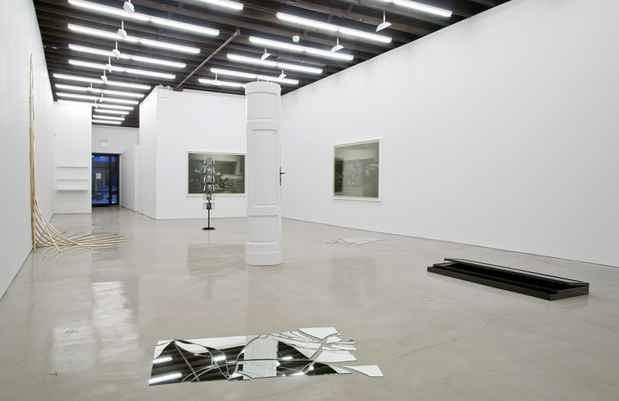Becky Beasley & Alicja Kwade Exhibition
Lisa Cooley Fine Art

This event has ended.
Lisa Cooley presents a two-person exhibition by Becky Beasley and Alicja Kwade. Their works share an interest in industrial materials as well as dark, blunt and sometimes opaque formal qualities. Yet these dark aspects are rivaled by the artists’ engagement with the domestic, perception, literature or personal narrative. This is the first time either artist has shown at the gallery.
Becky Beasley’s work may first appear as subtle, quiet forms but quickly give way to literary worlds, tinged with autobiographical references. In this exhibition, Beasley will present a new group of works, Auxiliary Flora, which is comprised of two large photographs, AUX (I) (Passive Voice) and AUX (II) (Passive Voice),as well as a postcard rack work, Flora, A Life. The large photographs, drawn from her personal archive, depict piles of organic street rubbish in Athens, which, due to their scale, engulf the viewer and suggest the monumentality of nature. Green Plexiglas glazing suffuses the lumps of refuse with verdant, fertile possibility. Similarly, the green-tinted postcards of plants, trees, and flowers in Flora, A Life rotate on a revolving post card rack, suggesting a joyful cycle of growth and decay. The viewer is invited to take a postcard, which also features a text by the artist, in a sense sowing the seeds of the work out into the world.
A counterpoint to Auxiliary Flora is Steppe, a black, powder coated steel sculpture. This low lying, dark, floor bound sculpture hinges ever so slightly ajar, revealing a glossy, black Plexiglas top. The title, Steppe, imbues the work with the suggestion of a flattened landscape. Beasley’s sculptures have always conversed with her photography. Early photographs depicted objects covered in blankets and were thus abstracted. As these photographic forms transmogrified into sculptures, they assumed a domestic scale – pianos, books, or humans – and poetic function. In this case, Steppe’s inky landscape counterbalances Beasley’s verdant photographs, representing the bloodless, lifeless phase of nature’s cycle.
Alicja Kwade’s sculptures try to elongate time and space. They present themselves as solid, real, heavy things, created with industrial processes or from everyday conveniences like clocks, mirrors, cars, lamps, and watches, yet in Kwade’s hands they invert, misalign, and melt. Her sculptures subvert one’s expectations precisely because of their familiarity and physicality. Their crystalline elegance and cinematic scale only magnify their pull on one’s perception.
In Time Reversal Process I bronze rods twist around each other, cascading down the wall, suggesting a way to move both forward and backward in one’s own existence. Eadem Mutata Resurgo is a freestanding white door, curved ever so slightly as if inviting the viewer into an alternate universe. Kwade’s interventions seek to challenge and defy the law of physics. Double Fortune is two broken mirrors that mirror each other identically, as if a third mirror was reflecting a single image. This self-reflexivity is the evidence Kwade uses to argue that cause and effect do not always form a straight line.
Media
Schedule
from February 10, 2013 to March 17, 2013
Opening Reception on 2013-02-10 from 18:00 to 20:00